[Spring] Column unique 제약조건의 에러처리 삽질기
by
개요
Spring의 Entity 에서 Column(unique = true) 제약조건에 대한 핸들링을 하고싶었다.
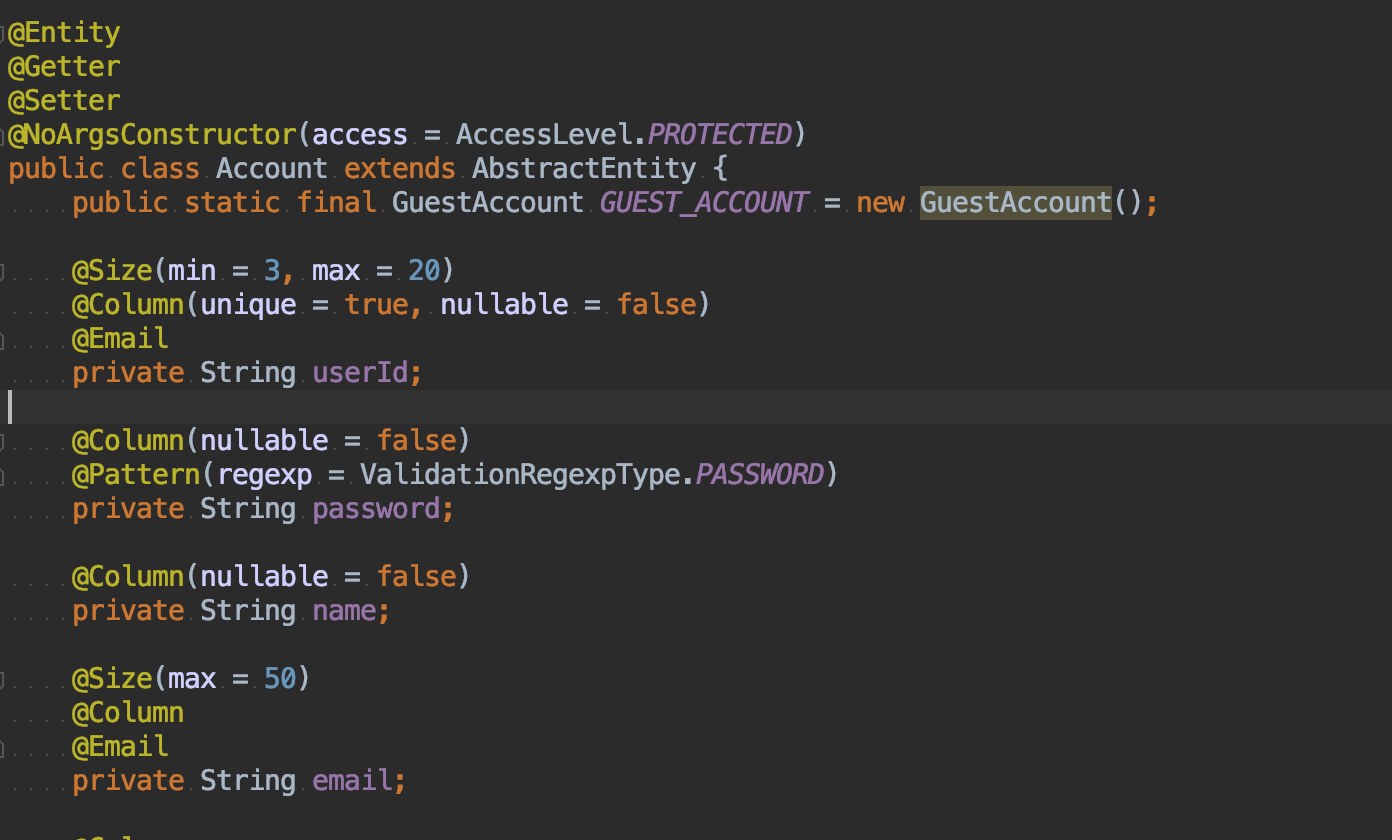
같은 userId로 회원가입 했을때 unique 제약조건에에 대한 에러 핸들링을 처리하고 싶다.
결론부터 말하자면 DataIntegrityViolationException / ConstraintViolationException 으로 Controller Advice 에서 또는 비즈니스 로직에서 try catch 구문으로 처리하시면 됩니다.
본문
1. 테스트 코드 작성
먼저 어떤 에러가 발생하는지 알기위해 중복되는 아이디로 계정을 생성하는 Acceptance Test를 실행시켰다.
@Test
public void create_not_unique_userId() throws Exception {
AccountRegistrationDTO account = AccountRegistrationDTO
.builder("test@google.com", "!Password1234", "!Password1234", "name")
.phoneNumber("010-1234-1234")
.email("test@google.com")
.type(AccountType.MEMBER)
.build();
ResponseEntity<String> response = sendPost("/member", account, String.class);
assertThat(response.getStatusCode()).isEqualTo(HttpStatus.CREATED);
assertThat(accountRepository.findByUserId(account.getUserId()).isPresent()).isEqualTo(true);
}
결과

Mysql Connector에서 MySQLIntegrityConstraintViolationException이 발생한것을 볼 수 있다.
필자 생각
필자는 MySQLIntegrityConstraintViolationException로 예외처리를 할경우 sql의 종류에 종속적인 코드가 될것이라고 판단하였고.
클래스의 extends를 타고올라가서 Connector에서 상속받아 구현한 클래스 보다 추상화레벨이 높은 클래스 SQLIntegrityConstraintViolationException 를 사용하기로 하였다.

ControllerAdvice를 이용하기전에 먼저 tryCatch구문으로 구현해 보기로 한다.
2. 에러처리 구현
구현
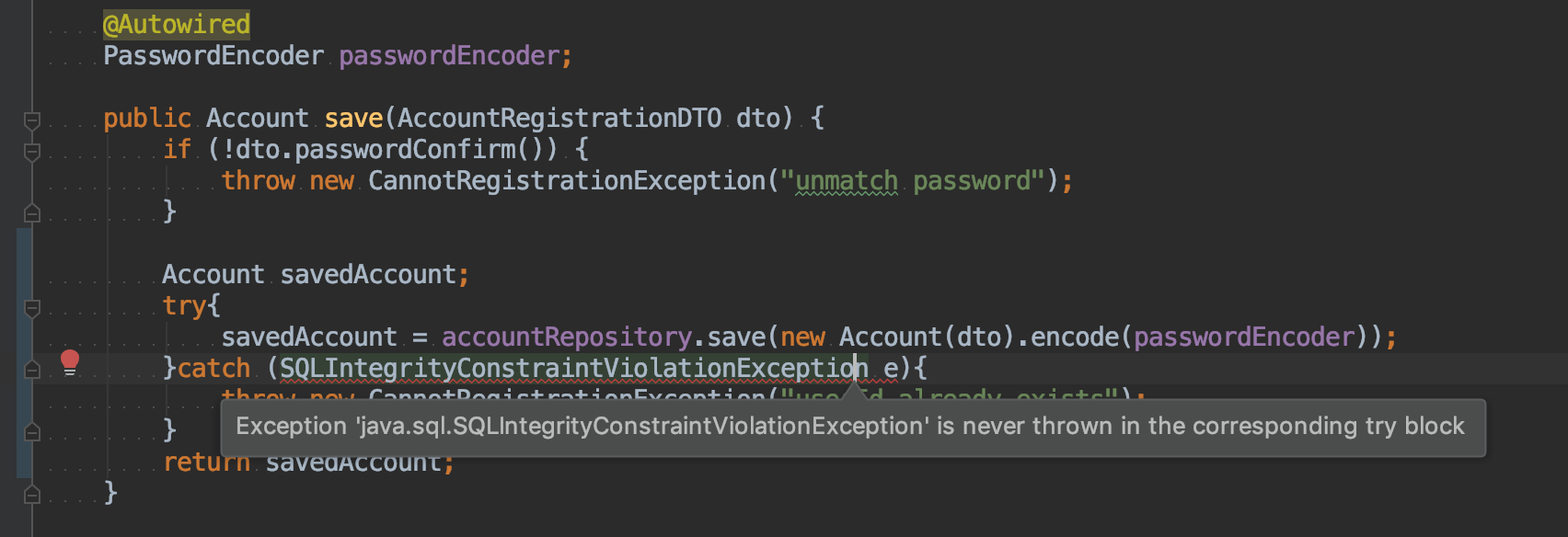
뭐..? 뻔히 테스트에서 에러가 로그에찍혔었는데 해당 에러가 발생하지 않는다고..?
-
혹시나 해서 MySQLIntegrityConstraintViolationException로도 catch 해보았지만 마찬가지
-
Test에 expected를 써볼까..?

expected를 써보아도 테스트가 깨진다.
흠.. 구글링을 해보자
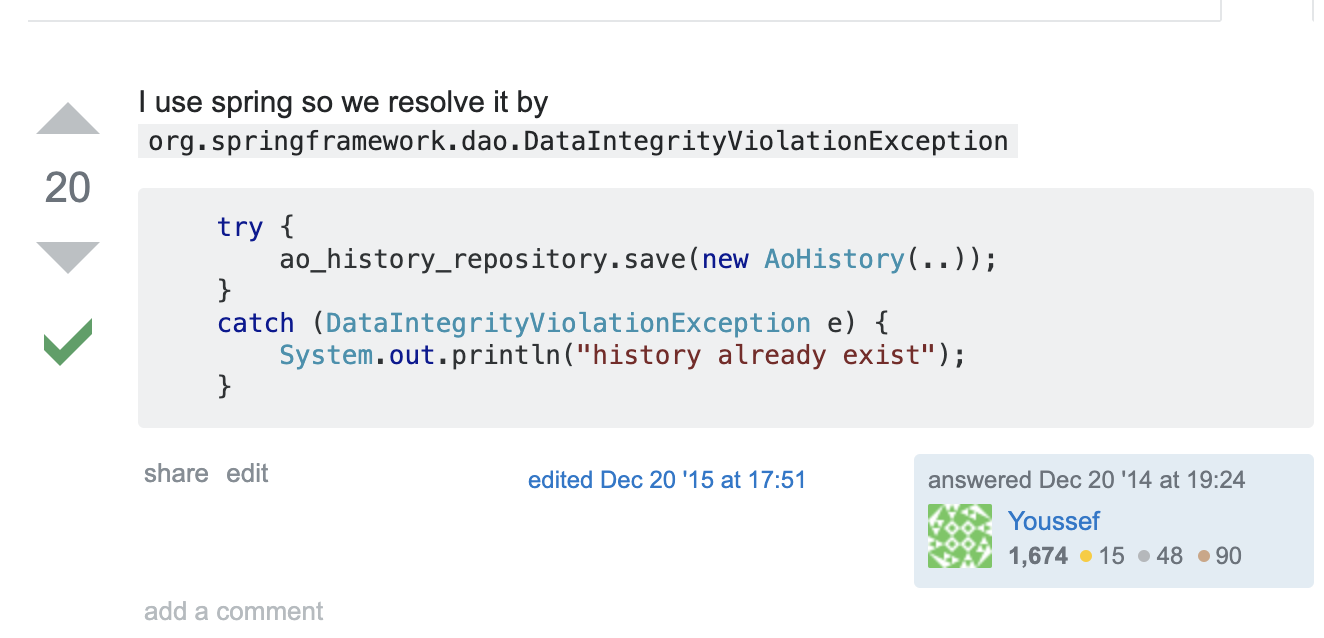
출처 : https://stackoverflow.com/questions/27582757/catch-duplicate-entry-exception
…?? 왜지 대체왜지..? 왜 보지도 못했던 Exception으로 에러를 처리하니까 catch가 되는거지?
하는 생각에 DataIntegrityViolationException를 에러에서 찾아보았다.

있다!!..?
내가 봤던 예외의 바로 위에서 던져진 예외였다.
내용
2019-04-21 17:36:05.532 ERROR 10016 --- [o-auto-1-exec-1] o.a.c.c.C.[.[.[/].[dispatcherServlet] : Servlet.service() for servlet [dispatcherServlet] in context with path [] threw exception [
Request processing failed;
nested exception is org.springframework.dao.DataIntegrityViolationException: could not execute statement; SQL [n/a]; constraint [UK_h6dr47em6vg85yuwt4e2roca4];
nested exception is org.hibernate.exception.ConstraintViolationException: could not execute statement
] with root cause
에러의 내용으로 봤을때 dispatcherServlet에서 던져진 에러다. 또한 hibernate의 ConstraintViolationException도 같이 던져진다.
필자생각
Spring 초심자의 생각의 흐름에 따라 이런 결론에 도달했다.
test에서 expected로도 검사가 안되고, catch로도 검사가 안된다. 그렇다면 스프링 내부(dispatcherServlet)에서 내가 검사하고 싶었던MySQLIntegrityConstraintViolationException 를 먼저 검사해서 가공된 예외를 던지는게 아닐까?
3. 예외를 가공해서 던져주는 코드 탐색
dispatcherServlet에서 던지는 예외 vs POJO에서 검출되는 예외의 차이 에 대한 학습을 할 필요성을 느꼈다. 어떤 구조로 예외가 가공되어 던져지는지 확인해보자.
에러발생의 객체인 dispatcherServlet과 Servlet을 뜯어본다.
Servlet

Servlet은 역시 인터페이스이다. 그리고 빈으로 관리되고 있다.
구현체로 가보자.

DispatcherServletAutoConfiguration
Servlet의 configuration에 도착하였고.


그렇다. dispatcherServlet을 구현체로 사용하고 있다.
dispatcherServlet클래스로 가보자.
dispatcherServlet
public class DispatcherServlet extends FrameworkServlet {
...
@Nullable
private List<HandlerExceptionResolver> handlerExceptionResolvers;
}
handlerExceptionResolvers를 리스트로 관리하고있다.
dispatcherServlet.initHandlerExceptionResolvers()
private void initHandlerExceptionResolvers(ApplicationContext context) {
this.handlerExceptionResolvers = null;
if (this.detectAllHandlerExceptionResolvers) {
Map<String, HandlerExceptionResolver> matchingBeans = BeanFactoryUtils.beansOfTypeIncludingAncestors(context, HandlerExceptionResolver.class, true, false);
if (!matchingBeans.isEmpty()) {
this.handlerExceptionResolvers = new ArrayList(matchingBeans.values());
AnnotationAwareOrderComparator.sort(this.handlerExceptionResolvers);
}
} else {
try {
HandlerExceptionResolver her = (HandlerExceptionResolver)context.getBean("handlerExceptionResolver", HandlerExceptionResolver.class);
this.handlerExceptionResolvers = Collections.singletonList(her);
} catch (NoSuchBeanDefinitionException var3) {
}
}
if (this.handlerExceptionResolvers == null) {
this.handlerExceptionResolvers = this.getDefaultStrategies(context, HandlerExceptionResolver.class);
if (this.logger.isDebugEnabled()) {
this.logger.debug("No HandlerExceptionResolvers found in servlet '" + this.getServletName() + "': using default");
}
}
}
여기서 빈으로 등록된 HandlerExceptionResolver를 리스트에서 추가해준다.
dispatcherServlet.processHandlerException()
@Nullable
protected ModelAndView processHandlerException(HttpServletRequest request, HttpServletResponse response, @Nullable Object handler, Exception ex) throws Exception {
ModelAndView exMv = null;
if (this.handlerExceptionResolvers != null) {
Iterator var6 = this.handlerExceptionResolvers.iterator();
while(var6.hasNext()) {
HandlerExceptionResolver handlerExceptionResolver = (HandlerExceptionResolver)var6.next();
exMv = handlerExceptionResolver.resolveException(request, response, handler, ex);
if (exMv != null) {
break;
}
}
}
if (exMv != null) {
if (exMv.isEmpty()) {
request.setAttribute(EXCEPTION_ATTRIBUTE, ex);
return null;
} else {
if (!exMv.hasView()) {
String defaultViewName = this.getDefaultViewName(request);
if (defaultViewName != null) {
exMv.setViewName(defaultViewName);
}
}
if (this.logger.isDebugEnabled()) {
this.logger.debug("Handler execution resulted in exception - forwarding to resolved error view: " + exMv, ex);
}
WebUtils.exposeErrorRequestAttributes(request, ex, this.getServletName());
return exMv;
}
} else {
throw ex;
}
}
handlerExceptionResolvers 리스트를 돌면서 예외 resolve를 진행한다.
필자생각
그렇다면, default로 리스트에 등록된 ExceptionResolver중에 우리가 찾는 녀석 (여러 에러들을 catch해서 가공시켜 던져주는 녀석)이 있는게 아닐까.
리스트를 찍어보자.
private인 리스트를 출력하기위해 get메서드도 찾아보고, DispatcherServlet을 상속받는 클래스도 만들어보고.. 여러 삽질을 한 자바초보. 처음부터 디버깅하는게 빨랐을거같다.
dispatcherServlet.processHandlerException() 디버깅

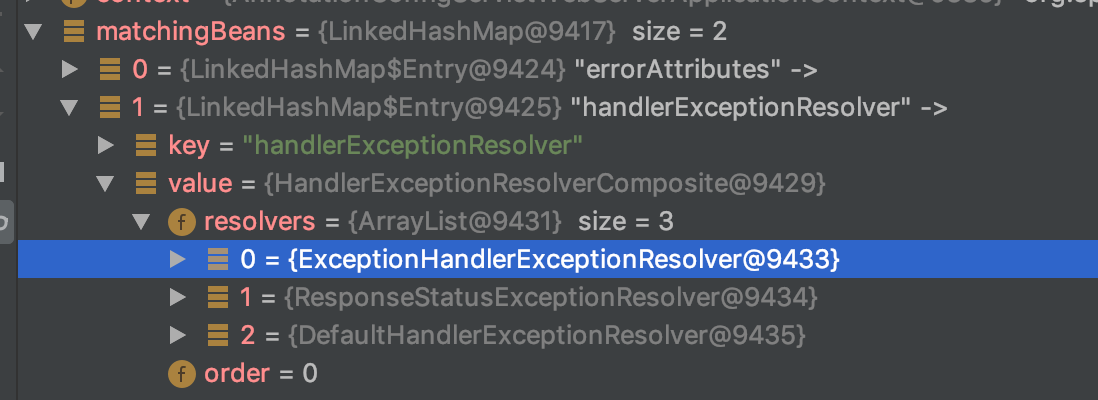
ExceptionHandlerExceptionResolver

소스를 보니 여러 에러처리 관련된 객체인듯 하다.
ResponseStatusExceptionResolver

message.property사용 관련된 객체로 보인다.
DefaultHandlerExceptionResolver


기본 에러 404 등등을 관리하는 객체로 보인다.
가장 필자가 찾는것과 적합해보이는 ResponseStatusExceptionResolver를 읽어보니..
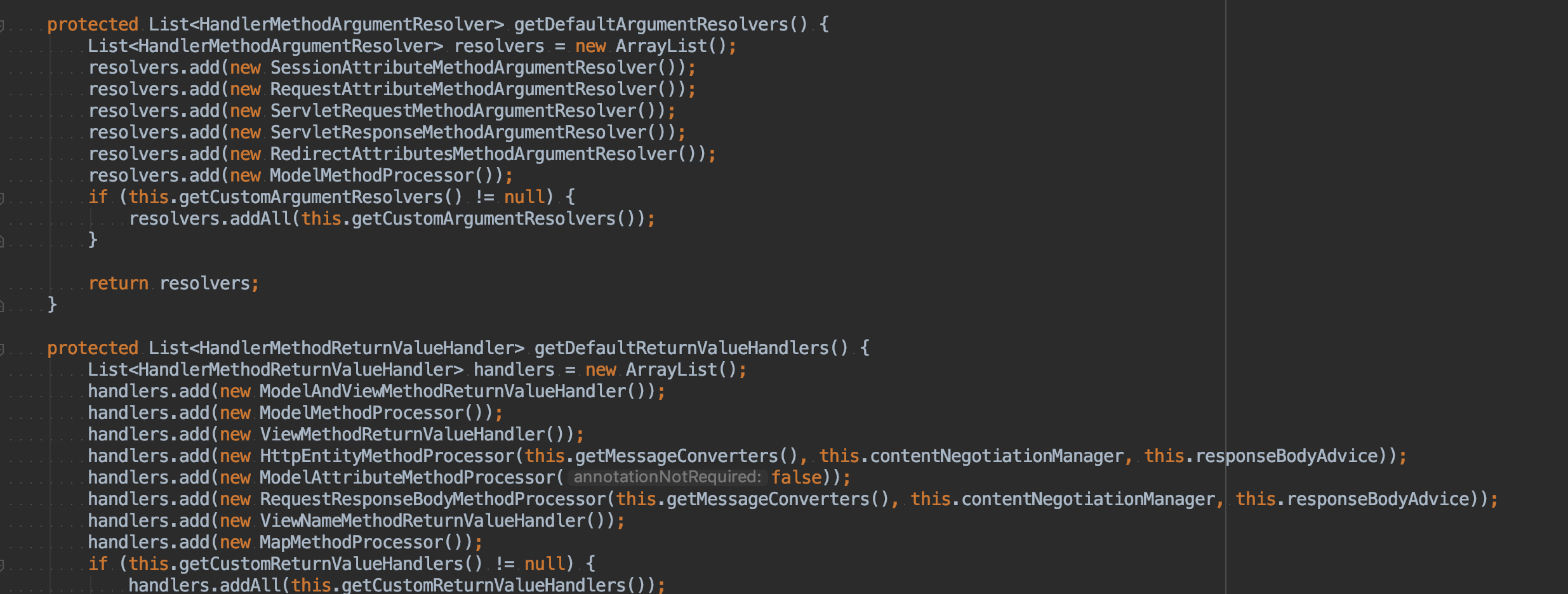
무수히 많은 Resolver들을 등록하고있다.
더 코드를 뜯어보면서 찾는건 학습 가성비가 떨어지므로 질문을 하기로한다. 꼭 sql exception을 다른 에러로 변환해주는 코드를 눈으로 확인하고싶다.
결론
처음 MySQLIntegrityConstraintViolationException의 검출로 시작했던 학습이
Dispatcher Servlet의 기능과 속성들을 파악하는 것으로 이어졌다.
이후 spring 에러처리에 대한 학습이 마무리 되면 정리해서 블로깅을 다시 하도록 하자.
Subscribe via RSS
